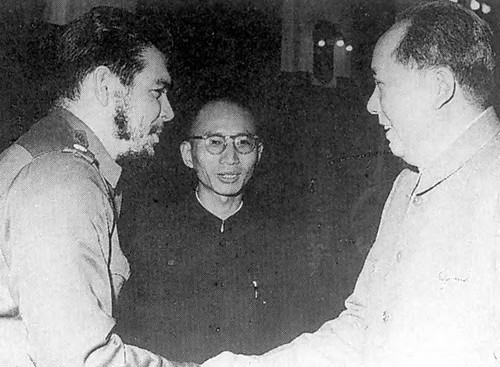
Che Guevara and Chairman Mao during the Cuban-Argentine revolutionary's visit to China in 1964. A high-level delegation from the Communist Party of China was in Cuba in April 2007., a photo by Pan-African News Wire File Photos on Flickr.
Letter to WW
Che Guevara’s work still alive in Cuba
Published Sep 2, 2011 6:45 AM
Dear comrades,
It is my great honor to greet you again!
As you are going to hold an important meeting in October 2011, paying tribute to Ernesto Che Guevara, I would like to submit the following short article about him.
As Che is an important example of internationalism, I think it is a good idea to publish information about him.
Once again, thank you very much. I really appreciate your solidarity.
In solidarity,
Ildefonso
Teacher
Cuba
Ernesto Che Guevara — the Heroic Guerrilla — was born in Rosario, Argentina, June 14, 1928. He rapidly acquired a broad education and rebelled against social injustice.
While still a student, touring Latin America, he came to understand the brutal exploitation of the workers, peasants and the Indigenous peoples. From that time on he dreamt of the revolution to emancipate the oppressed and exploited peoples of Latin America.
Having become a doctor, he traveled again. In Guatemala he defended the democratic regime of Jacobo Árbenz. He met some Cuban revolutionaries, among them Severino Rossell and Ñico López. Pursued by the FBI, Che left for Mexico where he met Fidel and Raúl Castro and he committed himself to our Revolution.
He joined the 82 on the expedition of the boat Granma as the doctor for the guerrilla army, but beginning with the first combat he took up arms and quickly became one of the most knowledgeable and intrepid guerilla fighters. He won promotions quickly until he reached the rank of Commander.
He fought in Alegría de Pío, La Plata, El Uvero, El Hombito, Pino del Agua and Mar Verde. On Aug. 31, 1958, he went to the front of the Column 8, “Ciro Redondo,” headed west. After a heroic march, he arrived at the Escambray Mountains. There Column 8 fought victoriously in Guiria de Miranda, and took Fomento, Cabaiguán, Placetas, Caibarién and Santa Clara. In this last city, he demonstrated his great capabilities as a political and military leader in the mobilization of the people and the derailment of the armored train. This battle was one of the decisive ones to drive out the tyrant.
In January 1959, after the triumph of the Revolution, Che assumed important functions in the Rebel Army, in the National Institute of Agrarian Reform (INRA) and in the Revolutionary Leadership. He ended up being the President of the National Bank and Secretary of Industries.
Che represented Cuba abroad in numerous economic and political missions. He made extraordinary contributions to the development of the revolutionary conscience of our people, particularly in the communist education of the youth. He contributed with valuable ideas on industrialization, the revolution in technology, productivity, savings, quality and other aspects of socialist construction.
In 1965, considering the Revolution completely consolidated, and faithful to his dream of going to fight for the emancipation of other peoples, he left his important functions in Cuba and put all his efforts to the internationalist cause in Africa and in Latin America.
Wounded and captured in Bolivia, on Oct. 8, 1967, he was murdered despicably by the minions of reaction and imperialism.
For the people of Cuba, Ernesto Che Guevara is a beloved symbol of the new human being. He is a banner of struggle for all the peoples of the world who fight to win or hold their independence and freedom.
----------------------------------------------
Articles copyright 1995-2011 Workers World. Verbatim copying and distribution of this entire article is permitted in any medium without royalty provided this notice is preserved.
Workers World, 55 W. 17 St., NY, NY 10011
Email: ww@workers.org
Subscribe wwnews-subscribe@workersworld.net
Support independent news DONATE
No comments:
Post a Comment